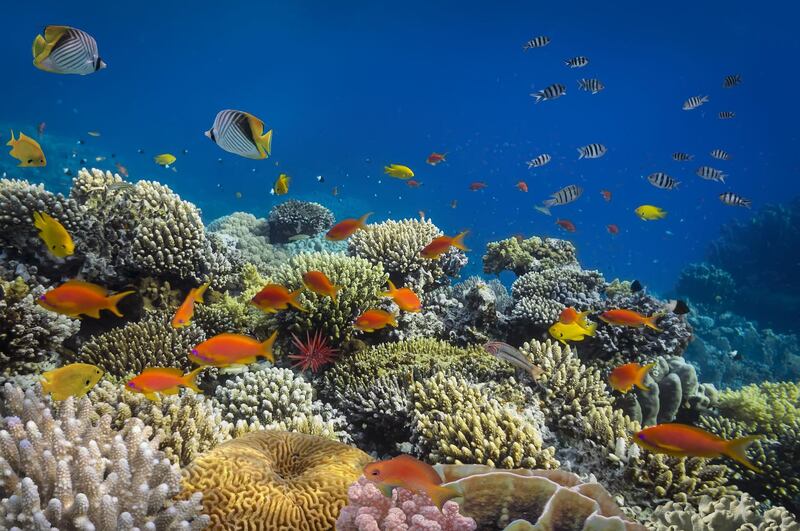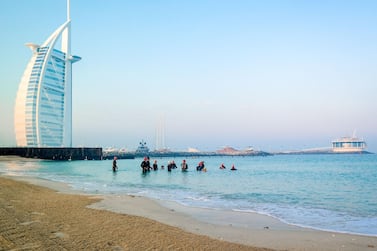The global pandemic has created a scuba-diving boom in the UAE. As a result of travel restrictions put in place to help curb the spread of the coronavirus, many people have found themselves staying put over summer, and have used this as an opportunity to discover the region's waters.
According to the Professional Association Diving Instructors, the GCC experienced its best July in 10 years in terms of student diver numbers. Updated regulations and new safety rules were quickly implemented by Padi to help dive centres safely maximise on this captive audience.
And while many of the travel restrictions that led to that boom are now easing, overseas trips are still filled with uncertainty as the world struggles to contain the virus. This means many newly qualified scuba divers are now looking to join those who already explore the UAE's oceans, to discover the underwater world in their own back yard.
And while it's not quite the Maldives, the UAE has a number of sites that offer a variety of diving experiences – from shallow to drift, wreck and wall. On the east coast, colourful marine life awaits, while interesting wrecks are to be found below the surface of the waters in Dubai and Abu Dhabi. Whether you're newly qualified or an underwater old-timer, here are six of the best diving sites across the country, recommended by those in-the-know.
1. Inchcape 1, Fujairah
For advanced divers looking to go deep below the waves, Inchcape 1 on the east coast of the country is definitely one to put on your list. Donated to the UAE's underwater landscape by Inchcape Shipping Services in 2001, the wreck is about 20 metres long and rests upright on its keel. The waters surrounding it flow into the Indian Ocean, which means the underwater life here is quite different to what you'll find on the country's other coasts.
"This wreck offers an amazing variety of beautiful coral and marine life," says Dave Griffiths from Divers Down in Dubai and Fujairah. "It is a huge ball of marine life, so much so that you often have to move marine life out of the way to see the wreck properly."
2. Sharm Rock, Fujairah
Another spot on the east coast, suitable for novice divers, Sharm Rock (also known as Three Rocks) is located near a small fishing village in Fujairah. Here, divers will find plenty of marine life at very manageable depths. At high tide, the tips of the three rocks protrude from the surface of the water. If you look closer when the tide is lower, you may spot a small fourth peak.
“This is the perfect site for entry-level divers with a depth of five to 13 metres. The site is made of three large pinnacles close together, with a crack running along the top,” explains Griffiths.
"It is full of shoaling fish and even has shoals of bannerfish, parrotfish and puffers."
Divers can also expect to find cuttlefish, turtles and perhaps some friendly jawfish.
3. Zainab, Dubai
The waters off Dubai are home to several wrecks and one of the most impressive is Zainab, a site that's ideal for advanced and experienced divers. When the 1969-built vessel sank off the coast of the UAE in 2001, many were worried that the oil spilling from it might reach the desalination plants responsible for the country's fresh water supply.
Now, settled at a depth of 30 metres on a flat sandy bottom about 40 minutes by boat from the Dubai coastline, the wreck is well worth exploring.
For Mohamed Helmy from Al Boom Diving Centre in Dubai, this is one of the best places to wreck dive in the UAE. "It's a shipwreck lying at a depth of 30 metres and has a lot of aquatic species to see," he says.
Countless marine creatures have made the wreck their home and divers can expect to see oysters and juvenile fish on its surface. There's also a good chance of spotting large rays, yellowtail barracuda, snappers and batfish.
4. Red Buoy, Abu Dhabi
Don't forget the capital when it comes to diving sites. For an expedition that guarantees lots of marine life, Abu Dhabi's Red Buoy is a good pick. It is a long-time haunt of Ocean Diving Centre at Emirates Palace marina.
"The visibility here is always good and there's lots of fish," says Teresa Danuco from Ocean Diving Centre. "The last time I went, I saw a whale shark, and that's the first time I've ever seen this since I've been diving in Abu Dhabi."
The site goes down to about 11 metres, so it’s good for novice or advanced divers and it lies about 19 kilometres off the coast of the emirate.
5. Dibba Rock, Dibba
The marine-protected site of Dibba Rock is suitable for new divers or those who feel less confident in deeper water. It goes down to about 14 metres so you can also have fun if you're more experienced, but it has a sloping rock that allows divers to easily stay in shallower depths if they prefer.
“Under the surface of Dibba Rocks lies a pinnacle stretching for 200 metres. The first part of the pinnacle is a steep wall and on top of that you’ll see tropical marine life and maybe a shoal of devil rays," says Griffiths from Divers Down.
"The second part of the dive around the island is a gentler sloping wall ending into a wall of mountain corals. Here you're likely to find blacktips, turtles and many tropical fish species."
There have also been reports of the occasional whale shark at this site.
6. Small shipwrecks, Abu Dhabi
Located about 30 kilometres off the coast of Abu Dhabi from Emirates Palace, the small shipwrecks offer underwater treasures well worth a visit. "The small shipwrecks is one of our favourite dive sites," says Danuco from Ocean Diving Centre.
Depending on the tide levels, divers can go down to about 12 metres. Below the waves, the wrecks crawl with marine life. It's possible to swim right inside the shipwrecks, where you'll get up close and personal with the hundreds of colourful fish that have made these sunken vessels in the Arabian Gulf their home.







